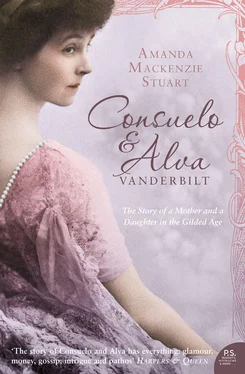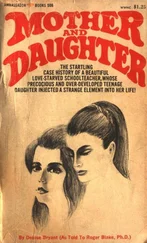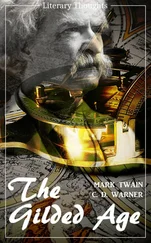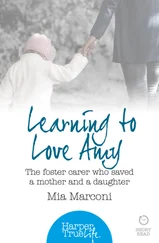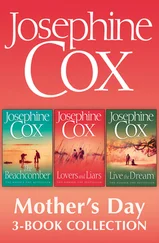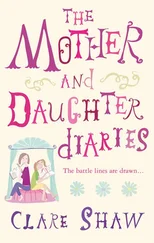The cruises often ended in Nice, and the party travelled to Paris, where the Vanderbilts spent May and June with their retinue. As a child Consuelo fell in love with Paris just as Alva had done. Here she could ride on the carousel, watch Punch and Judy on the Champs Elysées and sail her toy boat in the gardens of the Tuileries. Like her mother, Consuelo came to associate Paris with liberation. After months on the yacht she could play with friends from New York on the same international circuit – Waldorf Astor who would marry Nancy Langhorne, May Goelet who would be her bridesmaid and later marry the Duke of Roxburghe, and Katherine Duer, later Mrs Clarence Mackay, already demonstrating that she had a bossy streak. ‘She was always the queen in the games we played, and if anyone was bold enough to suggest it was my turn she would parry “Consuelo does not want to be Queen” and she was right,’ 86 wrote Consuelo later. For several years in succession the early summer months were spent in Paris, followed by a brief return to New York; Newport in June and July; and a few weeks at Idle Hour in the early autumn before returning to New York for the confined world of the winter season.
When Consuelo reached her mid-teens, Alva finally allowed her to attend ‘Rosa classes’ when they were in New York. These were classes given by a Mr Rosa to a group of six young ladies in the home of one of the pupils – in Consuelo’s case, the classes took place at the house of Mrs Frederick Bronson on Madison Avenue and 38th Street. Blanche Oelrichs attended the Rosa classes a year or two after Consuelo, and remembered Mr Rosa as ‘a very stylish gentleman, with sideburns and a heavy watch chain, whose ambition to die in Rome was eventually gratified’. 87 The classes lasted from eleven till one while Mr Rosa fought to cram in as much English, Latin, mathematics and science as he possibly could. Consuelo preferred studying English and history and kept her early essays for Mr Rosa on the Punic Wars until she died. Two hours each morning with Mr Rosa were followed by French, German and music lessons with governesses, and an hour of exercise in Central Park.
None of this meant that Consuelo was gradually permitted greater independence. Instead, such freedom as she had enjoyed as a child was steadily curtailed in her teens, and gave way to a life that was increasingly controlled and introspective. Her brothers became more distant as they went away to boarding school and as she grew older she was forbidden to join in with their holiday activities. By the time Consuelo was sixteen there were ‘finishing governesses’ in residence, one French and one English. Since French and English views about finishing young ladies were sharply divergent if not contradictory (and probably still are), these governesses had to be handled with great tact. Alva spent many hours in the schoolroom supervising the curriculum and directing the finishing governesses. Unable to resist a competition, she sent off for the entrance papers to Oxford University and ‘found that so far as [Consuelo’s] equipment went she could enter with a condition in three live languages and one dead one’. 88
Even by the standards of the day, Consuelo’s teenage life was highly managed. It is striking that cousin Gertrude Vanderbilt was permitted far more independence, in spite of the fact that Uncle Cornelius and Aunt Alice were serious and strict. Gertrude’s teenage diaries are filled with accounts of close female friendships, sorrow at leaving school, upsets about being too young to take part in ‘tableaux’, quarrels with her best friend and making-up. As Gertrude and her cousin Adele Sloane emerged from the schoolroom and into society, they were encouraged to form views about young men in the circle of aristocratic families in which they moved. Gertrude came home and analysed some of them: ‘You have not enough go. You are trustworthy without being interesting.’ [Mo Taylor]. ‘If anyone ever looked out for No. 1, you are that person.’ [Richard Wilson], ‘You mean well by people, but you will not take very much trouble to make yourself agreeable.’ [Lewis Rutherfurd]. 89 Adele was even allowed to go out riding with some young gentlemen, though she was never permitted to be alone with a man indoors (‘Had nobody in the older generation read Madame Bovary ?’ asks Louis Auchincloss in astonishment. 90 )
Alva would allow none of this. ‘My mother disapproved of what she termed silly boy and girl flirtations … and my governess had strict injunctions to report any flighty disturbance of my thoughts.’ 91 There were moments when the doll-child found such micro-management truly insulting: ‘I remember once objecting to her taste in the clothes she selected for me. With a harshness hardly warranted by so innocent an observation, she informed that I had no taste and that my opinions were not worth listening to. She brooked no contradiction, and when once I replied, “I thought I was doing right,” she stated, “I don’t ask you to think, I do the thinking, you do as you are told”.’ 92
In America in the 1890s there were many constraints on the lives of well-to-do young ladies: few telephones, no motor cars, corsets, long skirts, hats fixed with pins, gloves and blouses with high whalebone collars. Even at Bailey’s Beach at Newport, Consuelo bobbed up and down in the water in an outfit of dark blue alpaca wool consisting of a dress, drawers, stockings and a hat. It is perhaps not surprising that almost two pages of her memoirs are given over to a long list of the books she read in French, German and English. One German governess in her teens particularly inspired her with a love of German poetry and philosophy – to such an extent that after her marriage Consuelo considered translating Also Sprach Zarathustra into English, only to discover that there were twenty-seven translations already in existence. Meanwhile, she was inspired to secret but short-lived experiments in austerity by Plutarch’s Lives (she spent a night on the floor, but caught a cold) and reached a ‘real emotional crisis’ when she found a copy of Mill on The Floss in the yacht’s library. The picture Consuelo paints of herself as a somewhat sensitive, solitary and rather bookish teenager is reinforced by an entry in the diaries of the household superintendent, William Gilmour. On Thursday 2 March 1893, he wrote: ‘Miss Vanderbilt’s birthday, 16 years old. I went down to Wintons [Huttons] 23 St this morning and bought 3 vols Keats poems for Willie’s present to his sister.’ 93
For many years, the marriage of Alva and William K. Vanderbilt had been propelled by shared ambition. They had conquered New York society together, paving the way for other Vanderbilts, particularly Cornelius II and Alice, to take their place at the apex of New York society. By the mid-1880s, William K. and Cornelius II were members of all the most exclusive gentlemen’s clubs. Between them, the Vanderbilts had a row of magnificent houses on Fifth Avenue. Alva had undermined Mrs Astor’s monopoly to such an extent that it had become a newspaper joke to talk about the ‘Astorbilts’. Alva made her mark on New York’s architectural history too, forging an important creative link with its greatest architect, Richard Morris Hunt. But these achievements came at great emotional expense. Even by 1885, when William Henry’s death made the William K. Vanderbilts one of the richest couples in America, the glue of shared ambition had dried out. Consuelo’s sixteenth birthday in 1892 may have been celebrated with a thoughtful present from her brother; but the next two years would be deeply scarred by the unhappiness already engulfing her parents.
* approximately $13.9 billion today
** approximately $20.7 billion today
Читать дальше
